Location
The Watergate complex is a superblock bounded on the north by Virginia Avenue, on the east by New Hampshire Avenue, on the south by F Street, and on the west by the Rock Creek and Potomac Parkway. It is in the Foggy Bottom neighborhood overlooking the Potomac River, adjacent to the Kennedy Center and the embassy of Saudi Arabia. The nearest Metro station is Foggy Bottom-GWU.
The Principal Players (Design, Construction, Development Teams)
Listed on this page are snapshots of the companies and teams who were the hands on development and construction teams: sponsor and financing, architects, project management, lighting, general contractor, landscaper, engineering teams, and sales and management.
The Site
For more than a century, the site on which the Watergate complex now stands had originally housed the Gas Works of the Washington Gas Light Company, which produced "manufactured gas" (a mixture of hydrogen, carbon monoxide, methane, and other flammable and nonflammable gases) used for heating, cooking, and lighting throughout the city. Gas production ceased at the site in 1947, and the plant was demolished shortly thereafter.
The 10-acre site, purchased from Washington Gas and Light Company in 1960, contains an office building, three apartment buildings, and a hotel-office building. Construction was delayed for several months while the developer, government officials, and others debated the appropriateness of the complex's architectural style and height. Construction began in August 1963, and, after additional controversy over the height and siting of the fifth building, was completed in January 1971.
The Vision
From the initial vision of developing a master-planned urban community within the central political and cultural centers of Washington DC -- a town within a city, the Watergate cooperative properties became architect Moretti’s masterpiece as he was the chief architect of this elegant and sophisticated building construction that was completed in 1971, at a total cost for the entire project, once finished, of $78 million. He envisioned developing luxury residences into an urban lifestyle community named The Watergate Residences Washington Community.
The Watergate complex, envisioned as "a city within a city," was to provide so many amenities (24-hour receptionist, room service provided by the hotel, health club, restaurants, shopping mall, medical and dental offices, grocery, pharmacy, post office, and liquor store) that residents would not need to leave.
The design of the apartment buildings included two-story units which would occupy the first and second floors, while the units on the uppermost floors had private rooftop terracse and fireplaces. The design for the entire complex also envisioned an electronic security system so extensive that it would be almost impossible for intruders to get into the grounds undetected.
The project was originally projected to cost $75 million and consisted of six 16-story buildings comprising 1,400 apartment units, a 350-room hotel, office space, shops, 19 luxury "villas" and three-level underground parking for 1,250 vehicles.
The Landscape Vision
Boris V. Timchenko, a noted D.C.-based landscape architect, supervised the design of the grounds (which included more than 150 planters, tiers of fountains designed to create sounds like a waterfall, landscaped rooftop terraces, swimming pools, and a seven-acre park). Landscape features, such as planters, would also be used to create privacy barriers between apartments. More on Mr. Timchenko here.
The Town within a City
The five curving towers of "Watergate Towne" were the District of Columbia's first major international real estate development -- the vision of Hungarian-born financier Nicholas Salgo and the Italian firm, Società Generale Immobiliare (SGI), based in Rome and owned in small part by the Vatican. SGI purchased the 10 acres, which constituted the plot of land on the defunct Chesapeake and Ohio Canal, in the early 1960's for US$10 million. The last lock, which diverted water from the Potomac River into the Tidal Basin at flood tide, was known as the "water gate." Italian architect Luigi Moretti designed the six buildings on the site: a hotel, two office buildings, three apartment buildings and a retail center.
The Italian Count di Carpegna was a project architect on SGI's staff, and the Countess de Rochefort was a sales representative for the Watergate East apartment cooperative.
The complex is a group of five buildings next to the John F. Kennedy Center for the Performing Arts in the Foggy Bottom neighborhood of Washington, D.C. in the United States. The 10-acre site contains an office building, three apartment buildings, and a hotel-office building. Construction began in August 1963, and, after additional controversy over the height and siting of the fifth building, was completed in January 1971. Considered still today as one of Washington's most desirable living spaces, the Watergate has been popular with members of Congress and political appointees in the executive branch since it opened.
The complex was the first mixed-use development (PUD: planned unit development) in the District of Columbia, and was intended to help define the area as a business and residential rather than industrial district. At the time, it was also the largest renewal effort in the District of Columbia undertaken solely with private funds.
The Name
The name of the complex was derived from the terraced steps west of the Lincoln Memorial that lead down to the Potomac River. The steps were originally planned as the official reception area for dignitaries arriving in Washington, D.C., via water taxi from Virginia, but they never served this function. Instead, 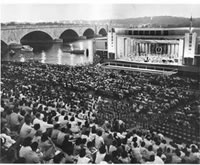 beginning in 1935, the steps served as bleachers, facing a floating performance stage on the Potomac River on which open-air concerts were held. Up to 12,000 people would sit on the steps and surrounding grass and listen to symphonies, military bands, and operas. The concerts on the barge ceased in 1965 when jet airliner service began at National Airport, making too much noise for music programs to continue.
beginning in 1935, the steps served as bleachers, facing a floating performance stage on the Potomac River on which open-air concerts were held. Up to 12,000 people would sit on the steps and surrounding grass and listen to symphonies, military bands, and operas. The concerts on the barge ceased in 1965 when jet airliner service began at National Airport, making too much noise for music programs to continue.
The steps are located beside the DC terminus of the Memorial Bridge and alongside Rock Creek Parkway, between the sculptures of the Arts of War and of the Arts of Peace, at the river side of the Lincoln Memorial. It's easily accessed directly from Memorial Bridge, or by crosswalks from the Lincoln Memorial.
The Design
SGI bought the 10-acre site from Washington Gas for $7 million, thinking it would soon be served by a freeway.
The Watergate's curved structures were designed to emulate two nearby elements. The first was the proposed Inner Loop Expressway, a curving freeway expected to be built just in front of the Watergate within the next decade. The second was the shape of the nearby Kennedy Center, then in the planning stage and whose original design was supposed to be curvilinear. Although the Kennedy Center later adopted a rectangular shape for cost reasons, the Watergate complex's design did not change. The curved structures would also give apartment dwellers an excellent view of the Potomac River. Because of the curves in the structure, the Watergate complex was one of the first major construction projects in the United States in which computers played a significant role in the design work.
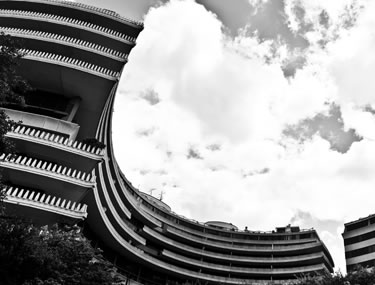
When models of the futuristic high-rises were unveiled by 1961, critics and zoning commissioners said the complex would ruin the waterfront and overshadow the planned performing arts center nearby, which was then on the drawing boards and would later be named after President Kennedy. The National Capital Planning Commission, according to a 1961 report in the now defunct Washington Star, questioned "whether the site should be developed at all."
The Star thought so. A May 1962 editorial stated: "It is true that the so-called "curvilinear' design is at variance with most commercial architecture in Washington. But in our opinion the result, which places a premium on public open space and garden-like surroundings, and which proposes a quality of housing that would rank with the finest in the city, would be a distinct asset."
Later that month, the White House urged the developer to accept a 90-foot height limit instead of the planned 130 feet.
Salgo and SGI's chief architect, Gabor Acs, flew to New York City with professor Luigi Moretti of the University of Rome to defend their designs in a special meeting with the federal Commission of Fine Arts, whose approval is required for any construction in the "Monumental Core." In the end, SGI was allowed to build 25% of the complex to 13 stories.
Moretti, who had designed the Montreal Stock Exchange and Rome's Olympic Village for the 1960 Games, served as a consulting architect. The Washington architecture firm of Corning, Moore, Elmore & Fisher also worked with the SGI staff architects. The builder was Magazine Bros. Construction.
Approval Controversies and Construction
Because the District of Columbia is the seat of the United States government, proposals for buildings in the city (particularly those in the downtown area, near federal buildings and monuments) must pass through an extensive, complex, and time-consuming approval process.
The approval process for the Watergate complex had five stages.
The first stage considered the proposed project as a whole as well as the first proposed building. The remaining four stages each considered the four remaining proposed buildings in turn. At each stage, three separate planning bodies were required to give their approval: The National Capital Planning Commission (NCPC), the District of Columbia Zoning Commission (DCZC), and the United States Commission of Fine Arts (USCFA) (which had approval authority over any buildings built on the Potomac River to ensure that they fit aesthetically with their surroundings).
Fourteen months after the project was publicly announced, NCPC voiced its concern in December 1961 that the project's 16-story buildings would overshadow both the Lincoln Memorial and the proposed "National Cultural Center" (later to be called the John F. Kennedy Center for Performing Arts). At the time, the District of Columbia had a 90-foot height limit on all buildings except for those located exclusively along business streets. To obtain a height waiver, SGI would have to include retail office space in the complex, but the site was then zoned only for apartment buildings. Thus, initial approval first had to be won from the District of Columbia Zoning Commission. By the time the DCZC met to consider approval in mid-April 1962, the cost of the project had been scaled back to just $50 million. Because the District of Columbia lacked home rule, DCZC planners were reluctant to act without coordinating with agencies of the federal government. Additionally, many civic leaders, architects, business people, and city planners opposed the project before the DCZC because they feared it was too tall and too large. By the end of April, DCZC had announced a delay in its decision-making.
The Commission of Fine Arts (USCFA) also had concerns.
The USCFA felt some of the land should be preserved as public space, and objected to the height of the proposed buildings as well as their modern design. Three days after the DCZC meeting, the USCFA announced it was putting a "hold" on the Watergate development until its concerns were addressed. To counter this resistance, SGI officials met with members of the USCFA in New York City in April 1962 and defended the complex's design. SGI also scaled the height of the Watergate back to 14 stories from 16 stories. The project was then reviewed by the NCPC in May 1962. Additional revisions in the design plan pushed the cost back up to $65 million, even though only 17 villas were now planned. Based on this proposal, the NCPC approved the Watergate plan. With the support of the NCPC, SGI dug in its heels: It declared it was not interested in developing the unsightly, abandoned commercial site unless its basic curvilinear design (now called "Watergate Towne") was approved, and it actively lobbied DCZC commissioners in late May (lecturing them on the District's architectural heritage and the beauty of modern architecture). SGI officials also lobbied the USCFA. Meanwhile, White House staff made it known that the Kennedy administration wanted the height of the complex lowered to 90 feet. Three key staff were opposed to the project on height grounds: Arthur M. Schlesinger, Jr., Special Assistant to the President; August Heckscher III, Special Consultant on the Arts; and William Walton, a Kennedy family confidante. The three briefed President John F. Kennedy on the issue, but it was not clear who made the decision to request the height reduction or who made the request public. The White House announcement surprised many, and offended federal and city planners (who saw it as presidential interference in their activities). SGI's chief architect, Gábor Ács, and Watergate chief architect Luigi Moretti flew to New York City on May 17 and defended the complex's design in a special three-hour meeting with USCFA members. SGI agreed to scale back 75% of the buildings in the development to just 13 stories (112 feet), with the remaining 25% of the buildings rising to 130 feet. SGI also agreed to add more open space to the project by scaling the size of the Watergate back to 1.73 million square feet from 1.911 million square feet and by reorienting and/or re-siting some of the buildings in the complex. The USCFA gave its assent to the revised construction plan on May 28, the White House withdrew its objections, and the DCZC gave its final approval on July 13. The final plan broke one building into two, creating five rather than four construction projects. Moretti later admitted he probably would have lowered the height of the buildings anyway, and thought the approval process had gone relatively smoothly. Construction was expected to begin in the spring of 1963 and last five years.
The Watergate project faced one final controversy, however. The group Protestants and Other Americans United for Separation of Church and State began a national letter-writing campaign opposing the project, alleging that the zoning waivers would not have been given had the Vatican not been a major investor in SGI. By mid-November 1962, more than 2,000 protest letters had been sent to Congress and another 1,500 to the White House. But the group's attempt to stop construction failed, and the project went forward.
The project won its $44 million financial backing in late 1962, and its construction permits in May 1963. Construction was planned to begin on the first building, the Watergate East apartment, in August 1963. Ground was actually broken in February 1964. The builder was Magazine Bros. Construction. Groundbreaking began for the headquarters of Riverview Realty, the leasing agent for the 200,000 square feet of office space planned in the complex in August 1963 (corrected based on Dedication Book to February 1964), and major excavation work was complete by May 1964.
The U.S. Commission on Fine Arts attempted once more, however, to significantly revise the project. In October 1963, the USCFA alleged that the height of the Watergate complex, as measured from the parkway in front of it, would exceed the agreed-upon height restrictions. SGI officials, however, contended that architects are required by law to measure from the highest point on the property on which they are to build; using this measurement, the building met the May 1962 agreement stipulations. On January 10, 1963, SGI and the USCFA agreed that the height of the complex would not exceed 140 feet above water level (10 inches below that of the nearby Lincoln Memorial), that fewer than 300 apartment units would be built (to reduce population congestion), and to eliminate the proposed luxury villas (to create more open space). Luxury penthouse apartments, however, could extend above the 140-foot limit if they were set back from the edge of the building and the 14th floor was foregone. With these adjustments, the total cost of the first apartment complex (excluding plumbing, electricity, and decoration) was estimated at $12,184,376. Construction proceeded. In September 1964, the Watergate's developers signed a first-of-its-kind agreement with the Washington Gas Light Co. for the utility to provide the entire complex with its heating and air conditioning. The building's foundation and basement were completed by September 1964, and the metal and concrete superstructure rose in October. Construction began on the second building, the 11-story office building and hotel, in February 1965.
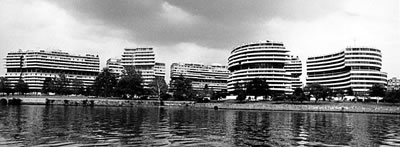
The first building, the 110-foot Watergate East was completed in May 1965, and a month later the first model apartment unit was opened to the public for viewing. The complex plan included an elaborate electronic security system, including closed-circuit televisions, two-way radios and a 24-hour security staff. It was believed to be the first major construction job to make significant use of computers. A forerunner of modern computer-aided drafting (CAD) technology was employed in plans for 8,000 square feet of irregular windows and 2,200 irregular wall panels. In 1964, Jim Roberts of Magazine Bros. told the Star: "We had to face the fact that there are no continuous straight lines anywhere -- horizontally on the floors or vertically on the facade. Not only were there many different curves on every floor, but no two floors had a facade exactly alike."
The building opened on October 23, 1965. The first tenants moved in a few days later. Prices for the 238 cooperative apartment units ranged from $17,000 for efficiencies to more than $250,000 for penthouses, and were almost completely sold out by April 1967. The average apartment contained two bedrooms, two-and-a-half baths, a dining room, and a kitchen, and cost $60,000. Parking space in the underground garage cost $3,000 per space. The tenants took title to their building on April 8, 1966. A Safeway supermarket, a Peoples Drug (now known as CVS pharmacy), beauty salon, barber shop, bank, bakery, liquor store, florist, dry cleaner, post office, upscale shops, and high-end restaurant took up residency in the retail space on the ground floor in November 1966.
The Watergate hotel and office complex opened on March 30, 1967, with the Watergate Hotel accepting its first customers the same day. The hotel's 12 stories initially only included 213 rooms, while the 12-story office building (attached to the hotel by a colonnade) had 200,000 square feet of office space. The combined hotel/office building included a health club (with indoor pool), space on the ground floor for shops, and a restaurant on the top-floor. Just 25 days later, the Democratic National Committee signed a lease for office space in the retail office portion of the building.
Construction on the fourth building in the complex, Watergate West, began in July 1967. Units in the unfinished building (prices ranges from $30,000 to $140,000 for apartments) began selling as early as October 1967, an indication of how popular the complex was with District residents. The third building (Watergate South) opened in June 1968 and the fourth building topped out on August 16, 1968. When completed, Watergate South was the largest building in the complex, with 260 units. By now, the cost of the project had risen to $70 million. Construction on Watergate West was completed in 1969.
Controversy arose over the construction of the fifth and final building. Excavation and clearing of the Kennedy Center site had begun in 1965, and construction in early 1967. Construction on the Watergate's fifth building was due to begin in the fall of 1967, and advocates of the Kennedy Center began agitating for a change in the height of the building in June 1965. Plans for the fifth building called for a 140-foot high structure with the upper floors set back to create more space and light. The general counsel for the Kennedy Center, however, told the USCFA that Watergate Town (the development had dropped the "e") was planning a 170-foot-high building which would harm the aesthetics of the Kennedy Center and intrude on the park-like setting surrounding it. The Watergate's attorneys asserted that their building would meet the agreed-upon 140-foot height limit. The disagreement over the Watergate's final building continued for nearly two years. Watergate apartment residents such as Senator Wayne Morse lobbied the USFCA, DCZC, and NCPC to force SGI to accede to the Kennedy Center's wishes. In November 1967, the USCFA reaffirmed its approval of the Watergate project. When the DCZC appeared on the verge of giving its approval as well, the Kennedy Center argued that the DCZC had no jurisdiction over the controversy. The DCZC disagreed, and re-asserted its jurisdiction. The Kennedy Center then argued that the DCZC had not properly considered its objections, and should delay its approval pending further hearings. The District's legal counsel disagreed, giving the DCZC the go-ahead to reaffirm (or not) its approval ruling, which the Zoning Commission did on November 30, 1967. Although it appeared that SGI was winning the legal battle over the fifth building, D.C. city planners attempted to mediate the dispute between the Kennedy Center and the Watergate and achieve a contractual rather than legal solution. Three separate proposals were made to both sides on December 7, 1967. On April 22, 1968, SGI agreed to turn its fifth building slightly to the southwest in order to open up the Watergate complex a little more and give the Kennedy Center some limited open space. Although the Kennedy Center accepted the proposal, it demanded that the fifth building include apartment units (rather than be completely devoted to office space) in order to maintain the residential nature of the area. The fight now moved to the NCPC. In June 1968, the NCPC held a hearing at which more than 150 Watergate apartment residents clashed with SGI officials over the nature of the final building. On August 8, 1968, SGI and the Kennedy Center reached a resolution, agreeing that only 25% of the fifth building's 1.7 million square feet would be used as office space and that the remaining space would become apartment units. The NCPC approved the revised plan in November 1968, and the DCZC did so five weeks later (specifically zoning the building for nonprofit and professional use only). The fifth building was completed in January 1971. Its first tenant was the Insurance Institute for Highway Safety (which secured occupancy in February 1971) and its first major tenant was the Manpower Evaluation and Development Institute (it leased the entire eighth floor). In October 1972, several high-end fashion boutiques, jewelers, and a restaurant opened in the fifth building in a retail space named "Les Champs."
The Buildings
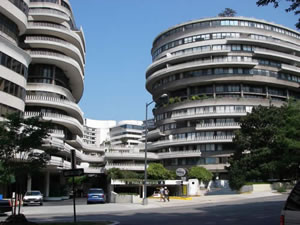
The six parts of the complex, five buildings and a retail area, are
- Watergate East - 2500 and 2510 Virginia Avenue, NW (occupancy in 1965, full cooperative in 1966).
- Watergate Hotel and Office Building - 2600 Virginia Avenue, NW (technically, the hotel's address is 2650 Virginia Avenue NW.) The hotel, opened in 1967l had 250 guest rooms and 146 suites. In 2004, the hotel was purchased by a company planning to turn it into luxury co-ops. As of 2012, it is being renovated as an upscale hotel by EuroCapital Properties. The office building was sold in 2005 by Trizec Properties to Bentley Forbes, a Los Angeles-based real estate investment firm for $500,000.
- Watergate West - 2700 Virginia Avene, NW (occupancy in 1969).
- Watergate South - 700 New Hampshire Avenue, NW (occupancy in 1971).
- Watergate Office Building - 600 New Hampshire Avenue, NW (signed first lease in 1971).
- The retail center offers a CVS pharmacy drug store, full liquor store, barber, beauty and nail shops, dry cleaners, gallery/framing,florist, travel office, a delicatessen, and other establishments, on the lower retail level. At street level, there is a bank and US Post Office. The West End branch of the public library will open in spring 2014.
The Watergate complex changed hands in the 1970's, and each building was sold off separately in the 1990's and 2000's. Strict lease agreements, however, have kept the apartment buildings in resident's hands.
In 1977, one of the Watergate's financiers (Nicholas Salgo) and Continental Illinois Properties bought SGI's stake in the development for $49 million. Two years later, Continental Illinois sold its interest to the National Coal Board Pension Fund in the U.K. Salgo did the same in 1986. The coal board pension fund put the Watergate complex up for sale in 1989, and estimated the complex's worth at between $70 million and $100 million. Several buildings were sold in the 1990's. The property was valued at $278 million in 1991.
The entire development was listed on the National Register of Historic Places on October 21, 2005.
Les Champs
In October 1972, a strip of fashion boutiques and jewelers opened under the name Les Champs. The 13,000 square feet of retail drew tenants such as Gucci, Yves St. Laurent and, according to the Washington Star, "the only boutique in this country which exclusively features Soviet-made goods." Manager Henry Winston warned Les Champs retailers not to exploit the scandal that had erupted from the DNC break-in; however, by the fall of 1973, the shops drew heavy traffic from curious tourists and scandal buffs.
Watergate East
The Watergate East apartment building is probably the second-best known of the five buildings in the development. It became the most sought-after living location in the city when it opened in 1965.
Problems with the building's construction became apparent shortly after its occupancy. The roof was leaking by 1968. The Washington Post published reports in October 1968 that SGI refused to fix the leaks unless residents dropped their opposition to the construction of the complex's fifth building. By 1970, problems at the complex led the press to dub it the "Potomac Titanic.". A lawsuit, filed in February 1970, sought exclusive access to the underground parking garage Watergate East claimed as its own, and demanded that the developer stop selling spaces in the residents' parking area. On March 2, 1971, residents of Watergate West filed a lawsuit against SGI in which they claimed their units had defective stoves, faulty air conditioning, leaky windows and balconies, and deficient plumbing and asked the developer to correct the structure's problems. SGI said the problems were similar to those with any new building, and that it had already spent $300,000 fixing things. SGI filed a $4 million counterclaim alleging "malicious embarrassment" and five years later paid residents $600,000 to settle the cases.
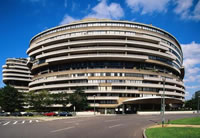
Watergate East was also the site of a major protest in 1970. In the weeks prior to the jury verdict in the trial of the Chicago Seven (in Chicago, Illinois), political activists began planning and then advertising that a protest would occur at the home of United States Attorney General John N. Mitchell (who lived in Watergate East). As expected, the verdict was handed down on February 18, 1970 (all the defendants were found not guilty of conspiracy but five were found guilty of incitement to riot). That night, more than 200 people rallied at D.C.'s All Souls Unitarian Church to prepare for the mass protest demonstration the next day. On February 19, several hundred protestors gathered in front of Watergate East and attempted to enter the building. Several hundred police, bused in to prevent the demonstration, engaged in street fighting with protestors, forced them to retreat, and eventually launched several tear gas canisters to disperse the crowd. More than 145 protesters were arrested. Although a second protest was expected the following day, it never emerged.
Watergate East tenant' cooperative refinanced its mortgage some time after 2000, and bought the land beneath its building.
Watergate Hotel
The hotel opened in 1967 and featured an upscale restaurant, the Roman Terrace. The DNC and other office tenants leased space in the hotel as early as April 1967.

2600 Virginia Avenue, NW Office building
The 2600 office building (located between East and the hotel) contains 198,000 square feet.
In 1972, the headquarters of the Democratic National Committee (DNC) occupied the entire sixth floor of the 11-story building at 2600 Virginia Avenue building. The DNC had occupied the space since the building opened in 1967. On May 28, 1972, a team of burglars working for President Richard M. Nixon's re-election campaign bugged the phones of and took photos in and near the DNC chairman's office.[9][86][120] The phone taps were monitored from the burglars' rooms (first Room 419, later Room 723) at the Howard Johnson's Motor Lodge across the street at 2601 Virginia Avenue NW. [9][86][119][120][121] During a second burglary on June 17, 1972, to replace a malfunctioning phone tap and collect more information, five of the burglars were arrested and the Watergate scandal began to unfold. [7][9][86][120][122] A plaque on the sixth floor of the office building portion of the Watergate Hotel commemorates the break-in. [123]
In 1993, the British coal board pension fund sold the office portion of the building (as well as the land under two of the three Watergate apartment buildings) to JBG Cos. (an American firm) and Buvermo Properties Inc. (a Dutch company). In 1997, JBG Cos. and Buvermo Properties sold the office building to the Blackstone Group's Trizec Properties division. Trizec put the office building up for sale for $100 million in 2005 and sold it to BentleyForbes Acquisitions LLC, a private firm owned by C. Frederick Wehba and members of the Los Angeles-based Webha family. BentleyForbes put the office tower up for sale on March 12, 2009.
Watergate West
Watergate West, the second residential building, was started in June 1967 and completed within two years. Like Watergate East, residents of West have discussed buying the land beneath their building when the land lease expires in 2070.
More on Watergate West construction, concrete phase, here. Please email if you would like photos of the concrete phase of the construction of Watergate West. Be specific as to what you are requesting and the purpose.
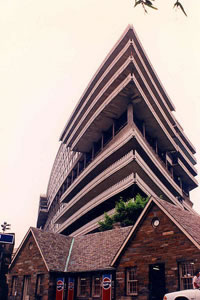
Watergate South
Watergate South has been the home to a number of notable individuals. Like Watergate East, residents of this building have discussed buying the land beneath their building.
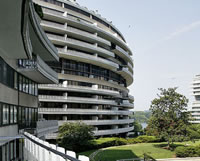
600 New Hampshire Avenue, NW Office Building
The Watergate 600 office tower, specially zoned for nonprofit and professional occupancy, signed its first tenant, the Insurance Institute for Highway Safety, in February 1971, and its first "major" tenant soon afterward: the Manpower Evaluation & Development Institute, which leased the whole eighth floor.
Britain's National Coal Board Pension Fund sold the Watergate Office Building to John Hancock Mutual Life Insurance in the early 1990s. The building underwent a renovation of its office spaces in 1994. The Atlantic Media Company owner David G. Bradley purchased the office building in 2003.
Dedication - October 1965

Trowels were given to attendees at the October 27, 1965 dedication, along with a program. The program booklet is available by email request.

A Place in History

The mixed-use complex next to the old canal "water gate", at the mouth of the now mostly underground Tiber Creek,1 owes its place in history to a little piece of masking tape that sealed the lock on a door and the fate of a president. It was Suite 600, leased by the Democratic National Committee (DNC), of the Watergate 2600 Office Building that burglars on the White House payroll entered around 2 a.m. June 17, 1972, to gather information about President Nixon's opponents.
The ensuing scandal led to the imprisonment of top White House staffers and the only presidential resignation -- and it made the name "Watergate" synonymous with political scandal and investigative journalism.
The Watergate's most historically significant office tenant, the DNC, moved out shortly after the break-in, transferring the bulk of its staff and files to George McGovern's presidential campaign headquarters at 19th and K Streets NW. The DNC kept a minimal presence in its infamous suite -- which was allegedly bugged again four months later -- until its lease expired in January 1973. The 16,000 square feet of history were leased to the National Academy of Sciences in August 1974.
Società Generale Immobiliare (and the Vatican connection)
SGI (in English, The General Company of Real Estate) was the largest Italian real estate and construction company. It was founded in Turin in 1862 but then moved to Rome in 1870 with the unification of Italy. After moving to Rome, the company became interested in the pastoral land around Rome and ended up buying it. With the growth of Rome, the company grew as real estate prices rose. With time, the company's activities changed from focusing on real estate to focusing on construction. One of the people to lead Immobiliare in the construction direction was Aldo Samaritani who joined the company in 1933. The company is famous for building numerous residential buildings throughout Italy.
Immobiliare's largest share holder was the Vatican with a 15% of the shares however most of its holdings in the company were sold in the late 60s to Gulf Western. It is the predecessor of Group SGI which was brought under the control of the Opus Dei in the early 1990's. The company was also involved in the scandal of Banco Ambrosiano.
The entire Watergate complex was initially owned by Watergate Improvements, Inc., a division of SGI. In 1969, the Vatican sold its interest in SGI and no longer was part-owner of the Watergate.
The Freeway
The Inner Loop were two planned freeways around downtown Washington, D.C. The innermost loop would have formed an oval centered on the White House with a central freeway connecting the southern segment of the oval with the northern segment and then continuing on to Interstate 95. Interstate 95 would have met Interstate 66, Interstate 295, Interstate 695, and US 50 while traversing the Inner Loop (the clockwise-traveling lanes of the Capital Beltway are also called the inner loop.). A second loop was an arc across the northern section of the city, beginning at East Capitol Street at the Anacostia River and utilizing the Missouri Avenue NW and Nebraska Avenue NW commercial corridors to terminate in Georgetown.
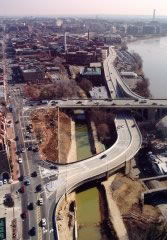
In 1956, federal and regional transportation planners proposed an Inner Loop Expressway composed of three circumferential beltways for the District of Columbia. The majority of the innermost loop would have been a minimum of six lanes, with the portions used by I-95 having a minimum of eight lanes. The final design for the innermost loop made heavy use of cut-and-cover tunnels in order to minimize impacts to the city; one notable example that was built is the tunnel (between C Street SW and D Street NW) under the National Mall used by the Interstate 395.
The innermost beltway would have formed a flattened oval centered on the Kennedy Center/Watergate complex in the west, running southwest along what is currently Ohio Drive SW until it linked with the Southwest Freeway portion of I-395, north along I-395 to L Street NW, and then west along an underground tunnel beneath K Street NW to join near the western nexus with the Whitehurst Freeway and Interstate 66—completing the loop.
The middle beltway would have formed an arc along the northern portion of the city, running from the proposed Barney Circle Freeway (whose terminus would have been near Robert F. Kennedy Memorial Stadium) through Anacostia Park, cut northwest through the Trinidad neighborhood along Mt. Olivet Road NE, followed the Amtrak rail line north to Missouri Avenue NW, along Missouri Avenue NW to Military Road NW, along Military Road NW across Rock Creek Park to Nebraska Avenue NW, down Nebraska Avenue NW to New Mexico Avenue NW, down New Mexico Avenue NW and across Glover-Archbold Park until it terminated near 37th Street NW at the north end of Georgetown.
The outermost route, the Capital Beltway, would encircle the city of Washington.
D.C. residents strongly opposed both inner loops, upset that the freeways would have required the demolition of large numbers of houses and greatly affected city neighborhoods. As a result, all portions of the network that were not yet started were completely cancelled in 1977. This left some portions of the innermost loop incomplete, and the northern arc completely unbuilt.
More and photos here.
The First Burglaries - and other Scandals
Due to the personal nature of of this information, please email if you would like a link to this web page. Be specific as to why you are requesting this.
Notable Residents
Due to the personal nature of of this information, please email if you would like a link to this web page. Be specific as to why you are requesting this.
---------------
